Syd Helicopter Tutorial
(Version 108b2.1)
Creating a SYD Patch which
simulates the sound of a HELICOPTER Back
to Tutorials Menu
- Close any open SYD
files.
- Choose NEW under the
FILE menu to open an empty Syd document.
- Click and drag a RANDOM
NOISE OPERATOR from the operator palatte (that's the one with the queston
mark on it -- ?) down to the main part of the window.
- Next, click and drag
a BUTTERWORTH FILTER OPERATOR from the operator palatte.
- Connect the output
of the RANDOM NOISE OPERATOR to the input of the BUTTERWORTH FILTER OPERATOR.
- Connect the output
of the BUTTERWORTH FILTER OPERATOR to the MAIN OUTPUT.
Your window should look something
like this:
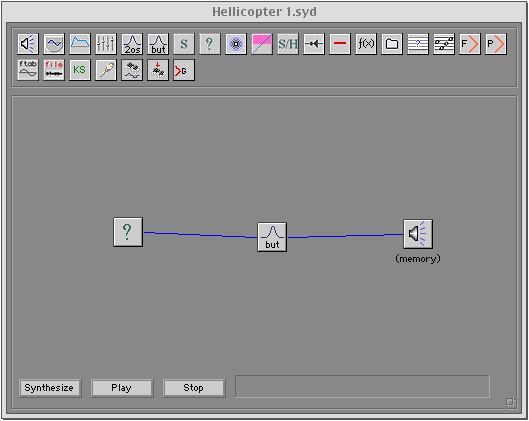
The RANDOM NOISE GENERATOR
creates NOISE such that all frequencies and all amplitudes are randomly giving
a steady output of what would sound like 'radio static.'
The BUTTERWORTH FILTER
is a variable band filter which allows four types of filtering:
-
High Pass
- Low Pass
- Band Pass
- Band Reject
Double-click on the BUTTERWORTH
FILTER to open its edit window. It should look like this:
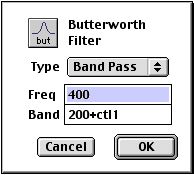
Set the values in the
various fields so they show these values. Specifically, random noise
will be passed to the filter. However, only a specific frequency of
noise will be allowed to pass through (400 Hz). The BAND 'width' will
be controlled by the variable, Ctl1. Think of the BAND WIDTH as
the filter's amplitude -- the wider the band, the more noise passes through
centered around the specific frequency contained in the FREQ field.
In other words, the wider the band, the louder the noise. The value
in the FREQ field controls the apparent pitch of the noise. A high value
would allow 'high-pitched' noise to pass through. A low value would
allow 'low pitched' noise to pass through.
Set the values in the
BUTTERWORTH FILTER as pictured above and then click OK.
Specifically, you are
setting the:
- TYPE = Band Pass
- Freq = 400
- Band = 200+ctl1
(the value '200+ctl1' will be explained below)
Now, drag an OSCILLATOR
OPERATOR down into the window. Connect the output of the OSCILLATOR
OPERATOR to the BUTTERWORTH FILTER.
Click and hold on the
above connection and then select the connection type as: ALT CONTROL SIG#1
[Ctl1]. See below for detail:
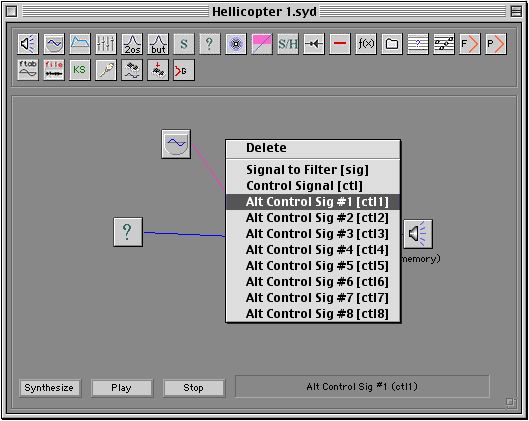
Set the parameters of
the OSCILLATOR OPERATOR to these values: Freq: 10; Amplitude: 200 (this
oscillator will contol the bandwidth of the filter by adding and subtracting
200 to the band width, thereby opening and closing the bandwidth).
Save your file.
Make sure the MAIN OUTPUT
OPERATOR is set to MEMORY and not to FILE.
Synthesize your patch
and then play it. It should sound like this (click below):
Helicopter1.aiff
Explanation for including
an offset in the Butterworth Filter Band field:
In the above patch, you are using
a sine wave Oscillator to control the opening and closing of the bandwidth
of the Butterworth Filter. This is what creates the characteristic oscillation
of the 'Helicopter' sound. If you send just the control signal (ctl1) to the
Band parameter field, then the Oscillator would send all values of the Sine
Wave (positive and negative) to the Bandwidth parameter field.
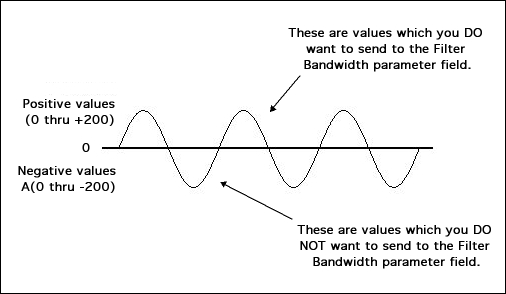
To cancel out the negative values
of the Sine Wave (0 thru -200), use an 'offset' in the Filter Bandwidth parameter
field which is equivalent to the AMPLITUDE of the modulating Sine Wave:

If you had trouble understanding
any part of the Helicopter Patch tutorial above, you may want to repeat earlier
parts of the SYD
TUTORIALS.
Variations
on the Basic Helicopter Patch: Lowpass Filter
A helicpoter
sound can also be achieved by using the LOWPASS filter instead of the BANDPASS
filter. However, this requires a slightly different technique:
When using the BANDPASS
filter, the helicpoter effect is achieved by modulating the BANDWIDTH with
a low frequency oscillator (LFO).
When using the LOWPASS
filter, the helicpoter effect is achieved by modulating the CUTOFF FREQUENCY
with a low frequency oscillator (LFO). You will still need to use an 'offset'
to compensate for the negative values generated by sine wave (see above).
Try this:
Use the same basic patch
as described above. Keep the settings of the modulating oscillator the same
(frequency = 10; amplitude = 200).
However, the parameter
settings for the Butterworth filter will look like this:
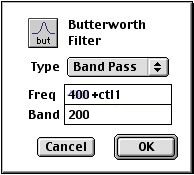
When the patch is synthesized,
it should sound like this: Helicopter2.aiff
Compare with the original
helicopter patch above:Helicopter1.aiff
Back
to Tutorials Menu
Main
Page

